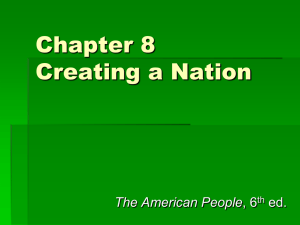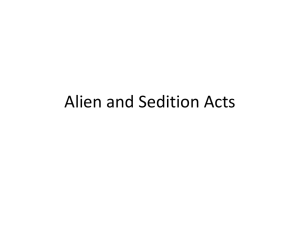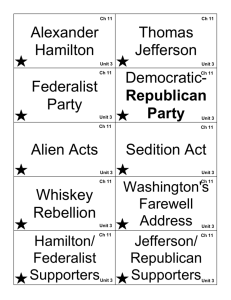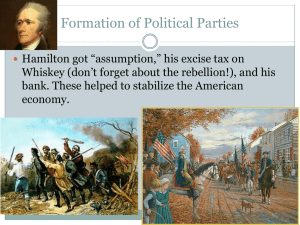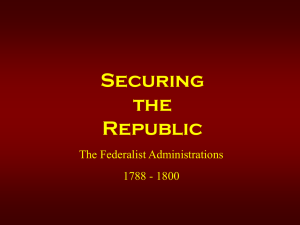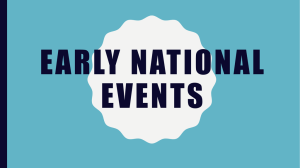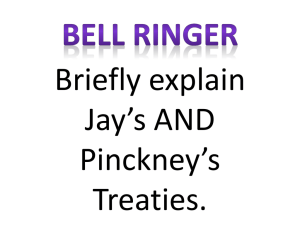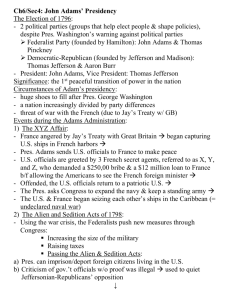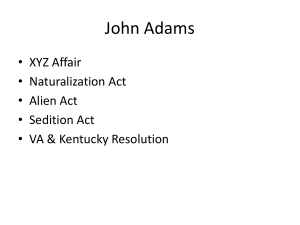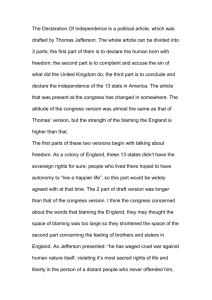Chapter 8 Creating a Nation
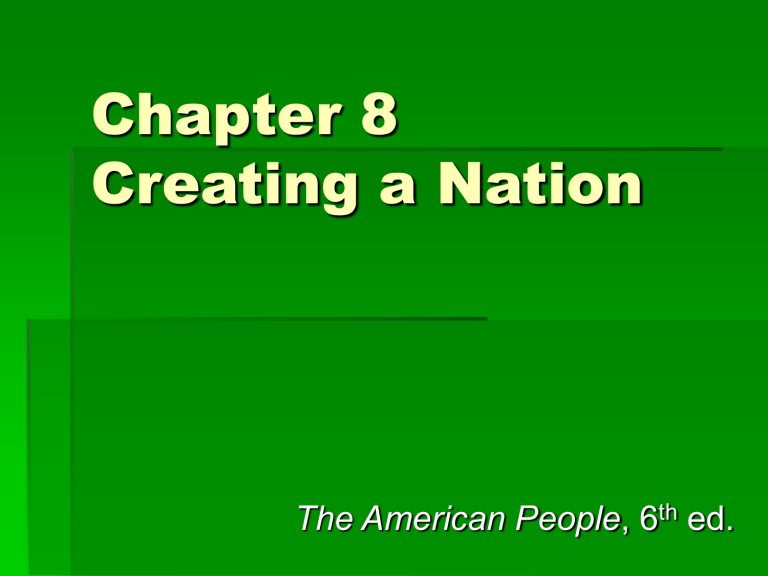
Chapter 8
Creating a Nation
The American People , 6 th ed.
I.
Launching the
National Republic
Beginning the New
Government
On April 16, 1789, George Washington was unanimously named president of the
United States by the Electoral College.
Many thought his inaugural speech was too reminiscent of the English monarchy.
Congress had to decide how to formally address Washington: “His Most Benign
Highness,” and other kingly titles fortunately gave way to “Mr. President.”
The Bill of Rights
Among Congress’s first tasks was debate over the constitutional amendments that several states had made conditional to ratification.
Congress argued the merits of twelve perspective amendments, finally selecting ten to become the national Bill of Rights.
Ratification of the amendments came in
December, 1791.
The People Divide
Criticism of the new national government was quick to appear.
Opposition groups had formed a united front called the Jeffersonian Republicans.
The administration’s supporters were known as Federalists.
Treasury Secretary Alexander Hamilton favored the federal assumption of all war debts incurred by the states.
The Whiskey Rebellion
The farmers of western Pennsylvania vented their anger at the federal government through an armed demonstration against the hated Whiskey
Tax.
Their livelihood depended on the transport of surplus grain in the form of distilled alcohol; this was easier to ship.
This pseudo-insurrection demonstrated the government’s vulnerability
II. The Republic in a
Threatening World
The Promise and the Peril of the French Revolution
France’s revolution began in 1789 as an effort to reform the injustices of a weakened monarchy and soon exploded into a radical rebellion with the beheading of Louis XVI.
For more than a decade the revolution dominated the stage in European politics.
The Democratic-
Republican Societies
Political clubs served as tools of democratic reform, providing safe havens for dissidents and intellectuals.
The Jacobin clubs in France were the most famous, but similar organizations appeared in the United States.
As early as 1792, constitutional societies were formed to oversee the rights of the people.
The increase in these clubs was spurred by the visit of Citizen Edmund Genet, French minister to the United States.
Jay’s Controversial Treaty
Alarmed by sinking relations with England,
President Washington dispatched Chief
Justice John Jay to London in 1794 to negotiate a number of disagreements left over from the Revolutionary War.
Jay’s Treaty contained only partial remedies to these problems and angered
Southern planters…there would be no compensation for their lost slaves.
III. The Political Crisis
Deepens
The Election of 1796
The presidential election of 1796 reflected the political uncertainty of the times as Washington announced he would not seek a third term.
The potential successor was narrowed to
Jefferson or John Adams, two very different men who had a great deal of shared experiences in the Revolution and the creation of the government.
Adams won the election, with Jefferson to serve as his Vice President.
The War Crisis with France
Adam’s first trial as president was the interference of American shipping by French naval vessels.
An American delegation was dispatched to Paris where arrogant administrators demanded bribes and promises of huge loans before they would allow them to see the French foreign minister.
Called the XYZ Affair, Adams recalled his delegation and denounced the French government.
The Alien and
Sedition Acts
The Federalist-dominated Congress acted to staunch the flow of aliens into the country through:
The Naturalization Act – raised citizenship requirement of residency from 5 to 14 years
The Alien Act – authorized the president to expel aliens whom he judged dangerous
The Alien Enemies Act – allowed the president to imprison or banish the subjects of any hostile nation at will.
The Sedition Act – made punishable by fine and imprisonment for anyone to conspire in opposition to the government.
The Virginia and Kentucky
Resolutions
Building on the protests that met the Alien and
Sedition Acts, the Virginia and Kentucky legislatures passed resolutions that directly challenged the federal laws.
The Kentucky Resolutions declared the federal government had violated the Bill of Rights.
The Virginia Resolutions declared the right of states to set aside a federal law found to be a threat to liberty.
IV. Restoring American
Liberty
Politics and the
Federal Courts
After a sweep of the presidency and the
Congress, the Jeffersonians prepared to purge several Federalist judges from the District courts.
Listing questionable charges, the Jeffersonians next impeached a Supreme Court Justice and seriously considered the impeachment of the
Chief Justice.
Fortunately, a constitutional crisis was averted to allow time and attrition cleanse the courts of the opposition.
Dismantling the Federalist
War Program
Jefferson ended any Federalist program that he saw as an affront to personal liberty.
Assuming the presidency, Jefferson freed jailed violators of the Alien and Sedition acts and let the hated laws expire.
Moreover, he disbanded the Federalist provisional army and reduced the size of the federal government.
V. Building an Agrarian
Nation
The Jeffersonian Vision
Political liberty could survive only under the specific conditions of broad-based social and economic equality.
The path to equality in a world valuing the pursuit of wealth was territorial expansionism.
The Windfall Louisiana
Purchase
James Monroe was sent to Paris by
Jefferson to buy West Florida and possibly New Orleans from Napoleon.
Incredibly, Napoleon wanted to sell all of the Louisiana Territory for $15 million.
The United States gained 830,000 square miles of new territory
